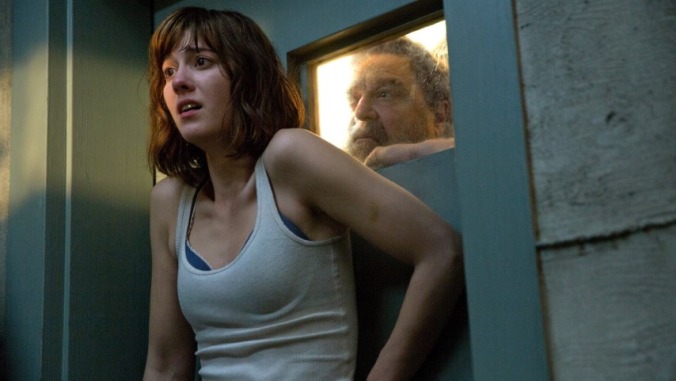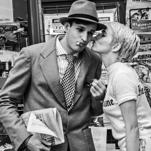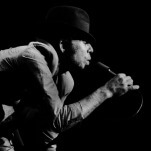The 20 Best Movies on MGM+ Right Now

Epix, the MGM-owned premium channel that also offers its service through digital platforms and the standalone Epix Now, has been rebranded as MGM+ to better reflect its corporate owner’s library of films. While its original offerings are squarely set in the TV realm (though MGM+ also has its fair share of exclusive stand-up specials), the best movies on MGM+ are worth digging into if you find yourself having access—either through the $5.99/month app or as a more traditional cable add-on.
The amount of films are more analogous to Starz or Showtime than a massive streamer like Netflix or even the similarly studio-owned Paramount+. At my last count, MGM+ has a nice round 250 films available and of those films, most are of a higher quality than the high percentage of filler that you’d find on a gigantic streaming service. It has a robust selection of horror, action, and drama—not to mention a slew of Westerns and the Star Trek films. We’ve curated a list of the best of the best, updated every month.
Here are the 20 best movies on MGM+ right now:
1. Nickel Boys
Year: 2024
Director: RaMell Ross
Stars: Ethan Herisse, Brandon Wilson, Hamish Linklater, Fred Hechinger, Daveed Diggs, Jimmie Fails, Aunjanue Ellis-Taylor
Rating: R
The experimental style of Nickel Boys recalls the more adventurous side of NYFF, where international directors will often bring formally rigorous, ambitious, or challenging films to an appreciative audience: For the most part, director and cowriter RaMell Ross constructs his film version of Colson Whitehead’s acclaimed novel entirely in point-of-view shots.
First, we’re only privy to the first-person experiences of Elwood (Ethan Cole Sharp, then Ethan Herisse), a Black high school student in the Jim Crow-era Florida of the early ’60s. We see what Elwood sees, which means not much of his actual face or body, catching a glimpse of him as a faded image in a store window, where he gazes at a row of television sets – or, in one beautiful shot, his reflection in the metallic trim of an iron held by his grandmother Hattie (Aunjanue Ellis-Taylor). Early in the film, Elwood, a strong student who qualifies to take classes at a local college, is wrongly accused of helping to steal a car. (He’s only just accepted a ride from a stranger.) The police send him to Nickel Academy, a reform school that Whitehead based on a real institution, trafficking in segregation and cruelty. Once there, Elwood, who earnestly believes he can work his way out of the system, befriends the more cynical Turner (Brandon Wilson), opening up a second avenue for POV shots. From there, the movie alternates between the two of them. Though they grow close, the two boys rarely get to share the frame – which makes one wonderful overhead-mirror shot, reproduced on the film’s poster, even more memorable.
Shot after shot, in fact, sticks in the mind; even when the movie technically breaks from the point-of-view approach, the effect still lingers. The occasional archival footage, by its nature and through the movie’s context, starts to feel like a POV shot, as if we’re sitting alongside whoever is watching or reading the material in question. Another seeming departure, where a fixed point of view continually shows an adult version of one character from just behind him, affixed to his body but outside of it, distinguishes those flash-forward scenes. Later, it’s revealed to make even more thematic sense than it originally seems. This might all sound very technical, and to some extent it is. But the discipline with which Ross adheres to his own rules belies what an intuitive, unrestrictive film he’s able to craft within and because of those constrictions. —Jesse Hassenger
2. Fargo
Year: 1996
Director: Ethan Coen, Joel Coen
Stars: Frances McDormand, William H. Macy, Steve Buscemi
Rating: R
In exploring the unsavory implications of “Minnesota nice,” the Coen Brothers created one of the most beloved, acclaimed and quotable films of all time. Fargo explores the tension that accompanies polite social norms and the quiet desperations they often mask, setting up one scene after another so awkward it’ll make your skin crawl. The emotional restraint displayed by such characters as Jerry Lundegaard (William H. Macy) and Mike Yanagita (Steve Park) is a thin and disingenuous veil over yearnings for money or companionship, while their foil, obviously, is Marge Gunderson (Frances McDormand), who really is that nice and hardworking and downright normal. The Coens strike a careful balance between gentleness and a stark gruesomeness underneath a typical all-American veneer, making you appreciate the art behind postage stamps as deeply as they make you cringe at the sound of a wood chipper. —Allie Conti
3. Challengers
Year: 2024
Director: Luca Guadagnino
Stars: Zendaya, Josh O’Connor, Mike Faist
Rating: R
There’s no need to know, or even enjoy, anything about the sport of tennis to find enjoyment in director Luca Guadagnino’s Challengers. Still, tennis is inextricably knotted to its sensuous love triangle, which evolves over the course of 13 tumultuous years, climaxing with a match between two estranged players whose love story eclipses the more overt romance between the pair and Zendaya’s tennis prodigy, Tashi Duncan. But it is a story of desire, love, power and co-dependency between three gifted young athletes who all hold that nagging fear, even in their early 30s, that their best years are behind them. The only thing that can reinvigorate their lost sparks is base, animalistic competition, like that which fueled their chaotic threesome over a decade prior to the lowly Fire Town challenger tournament in New Rochelle, New York. We first meet Tashi and Art Donaldson (Mike Faist), married and with a mostly neglected young daughter, after Tashi’s best tennis-playing days are behind her (due to a consequential leg injury) and Art is all but bereft of his mojo. In an effort to get his head back in the game and out of early retirement, Tashi enrolls him in a challenger: A small, U.S. Open qualifier that should be beneath an athlete whose face adorns ads the size of building facades. The goal is to have Art compete against players who are obviously below him in order to loosen him up and regain his confidence. The only problem is, it’s the same kind of minor sporting event that attracts a hard-up guy like Patrick Zweig (Josh O’Connor). Thirteen years earlier, Patrick and Art were both just two young tennis studs who once jerked off together (what guys can’t say the same?), in love with the same beautiful woman. Thirteen years later, one of them got the girl, the other is cosplaying as poor, and the former two haven’t spoken to the latter in years. The film is just as dynamic as its stars. Rapid cuts give the film a cohesive, kinetic rhythm that keeps the story in a near-constant state of momentum, and none of the frames the camera cuts to are superfluous compositions. This is matched by the occasionally dizzying camerawork from Gudagnino’s Suspiria cinematographer (also Apichatpong Weerasethkul’s on Memoria) Sayombhu Mukdeeprom. Challengers surprised me. It’s a grandiose, propulsive, erotic follow-up to the dull, Tumblr-core emo of Bones and All, and I found myself enthralled by Guadagnino’s latest, in which three of our hottest young actors convincingly, tantalizingly explore alternating dynamics of power and sexuality. Challengers isn’t really a film for tennis fans—it’s a film for fans of guys being a little gay for each other, and also fans of the kind of explosive yearning that’s even hotter than the sex scenes we all like to complain don’t exist anymore.–Brianna Zigler
4. Dirty Rotten Scoundrels
Year: 1988
Director: Frank Oz
Stars: Steve Martin, Michael Caine, Glenne Headly, Anton Rodgers, Barbara Harris
Rating: R
The story of two rival con men working a wealthy heiress is a comedy classic for two reasons: Steve Martin and Michael Caine. Watching Martin’s American street hustler Freddy Benson try to learn from and outwit his reluctant mentor, Caine’s refined British Lawrence Jameson, while they both desperately attempt to win a bet of swindling $50,000 from their agreed mark (Glenne Headly as Janet Colgate), offers plenty of laughs, even if the plot is fairly conventional. With Benson reduced to playing the dimwit Ruprecht, Steve Martin is in his physical comedy prime. —Josh Jackson
5. 10 Cloverfield Lane
Year: 2016
Director: Dan Trachtenberg
Stars: Mary Elizabeth Winstead, John Goodman, John Gallagher Jr.
Rating: PG-13
At its core, 10 Cloverfield Lane effectively works as an extended, modern-day riff on a Twilight Zone episode, a program producer J.J. Abrams holds near and dear to his heart. That’s not to say the resulting film feels like a lo-fi TV installment inorganically pumped up for the big screen. Quite the contrary, despite its enclosed setting and limited speaking parts, the film is very much a cinematic experience, with director Dan Trachtenberg (in his feature film debut) milking each interaction and set piece for maximum impact. What’s more, the script—the screenwriting debut from Josh Campbell and Matthew Stuecken alongside Whiplash writer-director Damien Chazelle—understands that sometimes the best way to raise tension is to allow it be deflated by humor (several tense sequences end with a chuckle rather than a gasp) before ramping it back up again. This well-calculated back-and-forth makes the film consistently nail-biting, yet never in a way that feels repetitive. By the time the film reaches its dramatic final stretch, the narrative has successfully escalated to a point wherein the crazier elements fit right in with the more grounded ones. —Mark Rozeman
6. Galaxy Quest
Year: 1999
Director: Dean Parisot
Stars: Tim Allen, Sigourney Weaver, Alan Rickman, Tony Shalhoub, Sam Rockwell
Rating: PG
J.J. Abrams once called this Star Trek parody one of the best Trek movies ever. He’s not wrong. Galaxy Quest is less interested in making fun of Star Trek than in making fun of Star Trek culture, from obsessive fans to goofy special effects to actors who alternately hate, resent or are proud of their time on the show. It also features one of Alan Rickman’s greatest roles, in case you’re one of those kids who only knows him from his Harry Potter stuff and wants to take in the full measure of the man.—Alan Byrd
7. True Grit
Year: 1969
Directors: Henry Hathaway
Stars: John Wayne, Glen Campbell, Kim Darby, Robert Duvall, Jeff Corey, Dennis Hopper, Strother Martin, H.W. Gim, John Fiedler
Rating: G
When you think of The Duke, what’s the first image that pops into mind? I’ll bet you he’s wearing an eye patch and a cowhide leather vest. Rooster Cogburn is arguably John Wayne’s most iconic role. The crusty, hard-drinking, hard-living, one-eyed U.S. marshal was launched into the Western film lexicon in 1969 in Henry Hathaway’s classic adaptation of Charles Portis’ classic novel. Chances are pretty good that Wayne’s portrayal will remain the definitive characterization despite an admirable and brilliant turn by Jeff Bridges in the 2010 remake by the Coen brothers. At times woodenly acted and downright dated by modern standards, the 1969 True Grit nevertheless has a primal power. It’s a coming-of-age story for young Mattie Ross (Kim Darby), a sharp-tongued quick-witted teenager, on a quest for revenge for her murdered father. She hires Rooster Cogburn to track down his killer, who has fled into Indian territory. Rooster admires her spunk, seeing reflections of himself in her stubbornness. Despite their prickly off-camera relationship, Wayne and Darby put aside those challenges and let the characters do the talking. Much of the movie’s beauty is in the deepening of their relationship, in Rooster’s protectiveness toward “Little Sis,” his appreciation and downright enjoyment of her pluck, and in Mattie’s wide-eyed admiration for her champion, a man with true grit. Never mind the many times he lets the bottle let her down. By the time Cogburn hauls snake-bitten Mattie on a desperate all-night journey through the wilderness, it’s hard not to be touched by his devotion and sheer determination to save Miss Ross’ life. The remake is a fine movie in its own right. It has a smoother flow, is truer to the spirit of the novel, and feels grittier to our modern sensibilities. Yet at its best, it can’t escape the shadow of the original and often feels like it is emulating its elder. Isn’t that the sincerest form of flattery, though? —Joe Pettit Jr.
8. Bull Durham
Year: 1988
Director: Ron Shelton
Stars: Kevin Costner, Susan Sarandon, Tim Robbins
Rating: R
I believe in ridiculous names like Crash Davis and Nuke LaLoosh. I believe in romantic comedies about giving up on a certain phase of your life where characters stand up and deliver cliched “I believe” speeches that, despite being borderline cheesy, somehow ring completely true. And yes, I too believe there should be a Constitutional Amendment banning Astroturf and the designated hitter. I believe in Bull Durham. The most engaging presentation of the minor-league life on film—and a pretty salute to baseball, in general—this first installment in the unofficial Kevin Costner Baseball Trilogy proved that baseball could equal big box office. Costner and Susan Sarandon anchor this film that does its part to engender a love for the game and the people who court it. —Bonnie Stiernberg & Michael Burgin
9. Face/Off
Year: 1997
Director: John Woo
Stars: Nicolas Cage, John Travolta
Rating: R
One of the best action bonanzas of the ’90s begins with the murder of a small boy, and the following 130 brilliant, dove-dunked, borderline lysergic minutes do nothing to denounce the glorious shamelessness of those very first moments. Contrary to contemporary narratives, Nicolas Cage has always been a bit much, but as swaggering sociopath Castor Troy (and then as traumatized lawman Sean Archer), the Oscar-winning actor seems to realize that everything has been building to this Face/Off, that perhaps he had been put on this earth for the sake of this film, and that director John Woo–already an action maestro by this point with The Killer, Hardboiled and Hard Target–should be his Metatron, recording and overseeing this important time in the Realm of Humans. Similarly, John Travolta leans just as hard into his half of the two-hander, saddled with the added pressure of playing a bad guy who’s playing a dad who lasciviously stares at “his” own teenage daughter, encouraging her to smoke by basically flirting with her, and like most Travolta performances from the past 20 years, fails spectacularly to not make it weird. With a plot (FBI agent undergoes experimental face surgery to pretend to be super criminal in order to trick super criminal’s less-super criminal brother into revealing the location of a bomb) that makes way less sense as a Wikipedia synopsis than it does on-screen, Face/Off should be a disaster. And hoo boy is it ever–plus a landmark in action filmmaking.—Dom Sinacola
10. The Wolf of Wall Street
Year: 2013
Director: Martin Scorsese
Stars: Leonardo DiCaprio, Jonah Hill, Margot Robbie, Matthew McConaughey, Kyle Chandler, Rob Reiner, Jon Favreau, Jean Dujardin, Jon Bernthal
Rating: R
The decade’s been both kind and not so kind to good ol’ Marty, ten years of bad takes questioning his credentials for directing Silence, for denying Marvel movies the honorific of “cinema,” for forcing audiences to showers en masse following screenings of The Wolf of Wall Street. And yet it’s impossible to keep him down; he’s immune to controversy and he thrives on lively debate, which is why, at 70 years old, his chronicle of the life, times and crimes of Jordan Belfort (Leonardo DiCaprio)—a stock broker and inveterate fraudster who bilked over 1,000 schlemiels, suckers and saps out of billions (and got off easy)—feels like something an artist half his age directed. The Wolf of Wall Street is a pissed off film. It’s also a horny, pervy, brutal, an impeccably made and fundamentally hideous film. At every passing image, Scorsese’s white-hot rage burns around the edges of the frame. The director has his own beefs and conflicts with his Christian faith, but here his presence is felt as a furious deity sitting in judgment on the fun Belfort has screwing over his clients, two-timing his first wife, jerking around his second wife and doing more blow in three hours than Scorsese himself did in the 1970s and ’80s. The easy knock to make against this movie is that it endorses the finance bro culture it navigates over the course of its running time, because at no point does Scorsese impose manufactured morality on what happens in front of us; instead he plays the hits as Belfort wrote them, showing the audience exactly what Belfort did while running his company, Stratton Oakmont, and while running around on his spouses. That the film ultimately ends with Belfort out on the prowl again is the ultimate indictment: Being rich allowed this man to get away with financial murder, because being rich, in the end, makes everything better. “Being rich makes everything better,” for some, is the movie’s embraced philosophy, but The Wolf of Wall Street doesn’t appreciate displays of wealth unhinged. It reviles them. Scorsese puts energy into the film, a spring in its every greedy step; one could call such debauchery without consequences a “good time.” But The Wolf of Wall Street doesn’t care about that kind of time as much as it cares about hanging Belfort out to dry. —Andy Crump
11. Teenage Mutant Ninja Turtles: Mutant Mayhem
Year: 2023
Director: Jeff Rowe, Kyler Spears (co-director)
Stars: Micah Abbey, Shamon Brown Jr., Brady Noon, Nicolas Cantu, Jackie Chan, Ice Cube
Rating: PG
A visual tour de force of hybrid 2D and 3D animation, Mutant Mayhem is not only the most authentically New York version of the Turtles yet, it’s arguably the most inventive. Rowe, Spears and production designer Yashar Kassai have rendered the brothers as if they’re hand-drawn, complete with messy sketch lines, doodle flairs and a graffiti aesthetic. This is the ultimate paint-outside-the-lines take on the Turtles and it works on every level. Teenage Mutant Ninja Turtles: Mutant Mayhem is swinging for the fences with its story and voice performances to ambitiously, quantifiably shake up the artistic rut that theatrical computer animation has been stuck in for the last two decades. Another plus is that the brothers are voiced by non-adult voice actors Nicolas Cantu (Leo), Brady Noon (Raph), Shamon Brown Jr. (Mikey) and Micah Abbey (Donnie), who recorded together, and were encouraged to excitedly talk over one another like a gaggle of real, tight-knit brothers would do. It translates into rapid-fire, organic quips and seemingly effortless timing that conveys a rapport that is singular to this iteration. It also elevates the script so that it doesn’t sound like it was written by a bunch of 40-year-olds trying to be hip and young. Rowe and Spears have a firm hold on their pacing, especially in how they use comedy to enhance their action beats. They also chart a progression to the brother’s battle prowess that is satisfying and pays off in satisfying full-circle moments. There’s also much to be admired in their choice to frame a lot of sequences with hand-held camera blocking, which leans into the unpredictable youth of the heroes that works so well in the gritty New York environs they’re sparring in. The filmmakers are also delightfully experimental throughout the Mutant Mayhem, using inspired live-action inserts, segueing into different artistic styles (including a homage to Eastman and Laird’s comic art) and embracing the asymmetrical character design that gives the film a fresh and energetic looseness. Rowe and company prove that there’s no strength to the myth of IP fatigue when you have the vision and passion to reinvent with such bold and fun intention.—Tara Bennett
12. Clue
Year: 1985
Director: Jonathan Lynn
Stars: Eileen Brennan, Martin Mull, Lesley Ann Warren, Tim Curry, Madeline Kahn, Christopher Lloyd, Michael McKean, Colleen Camp, Lee Ving, Bill Henderson, Howard Hesseman, Jane Wiedlin
Rating: PG
Clue is the definition of a cult classic: critics dismissed it, it stiffed at the box office, and during its brief stay in the theater it was known more for its multiple endings gimmick than its stellar cast or clever script. (Yep, those three endings you grew up watching on DVD and streaming were all released independently in theaters; the town I grew up in had exactly three first run theaters, and each one showed a different version of Clue at the exact same time.) It quickly grew a devoted fanbase once it hit VHS and cable TV, though, and not just because you could actually see every ending in a single sitting and not have to buy three movie tickets. Clue has one of the greatest casts ever assembled for a comedy, with each member pulling their own weight and then some. The chops of absolute pros like Brennan, Mull, McKean, and the rest more than compensate for what is actually a fairly thin script, with Kahn’s much-memed “flames” line reading still standing as one of the funniest scenes in movie history. Even though it wasn’t a hit, it remains a beloved classic comedy, and was a direct influence on Rian Johnson’s Knives Out movies. —Garrett Martin
13. Mission: Impossible—Dead Reckoning Part One
Year: 2023
Director: Christopher McQuarrie
Stars: Tom Cruise, Ving Rhames, Simon Pegg, Rebecca Ferguson, Hayley Atwell, Vanessa Kirby, Esai Morales, Pom Klementieff, Henry Czerny, Shea Whigham, Greg Tarzan Davis, Cary Elwes
Rating: PG-13
A scene in Mission: Impossible—Dead Reckoning Part One defines all Tom Cruise is and will ever be, arguably charting—in the language of death-defying action and in the voice of Hollywood A-lister beatitudes—the whole arc of contemporary blockbuster franchise filmmaking. Recovering with his team of Impossible Mission Force (IMF) agents following one of the worst catastrophes they’ve yet faced, Ethan Hunt (Cruise, asexual and totemic) admits to a new team member that, while he can’t guarantee he will keep them safe, he can guarantee that he’ll care more about their lives than his own. Not expecting such unmitigated humanity in the midst of such potential worldwide cataclysm, the new agent stares through welling tears. “But you don’t know me,” they say. “Does it matter?” Tom Cruise and Ethan Hunt both respond. Whether Cruise is capable of making a film that doesn’t reckon with his legacy? That’s not this one’s job. Helmed by director Christopher McQuarrie on his third go at M:I, Dead Reckoning Part One reaches back 28 years to the first film, not only bringing back Kittridge (Henry Czerny) as the head of the IMF, appointed apparently after Director Hunley’s (Alec Baldwin, ejected from the franchise with impeccable timing) murder in Fallout, but culling reverently from De Palma’s penchant for paranoid close-ups and canted angles, for long-held shots obsessed with the creased faces of defiantly sweaty men, studying their buttery eyes for omens. Dead Reckoning Part One’s plot, as convoluted as the best in the franchise, comes together stupendously. Every facet, from sound and set design to Cruise’s sheer athleticism to how McQuarrie knows exactly where to place the camera to embrace that athleticism, coalesces into a very real, often breathtaking sense of peril that’s mostly absent from every other IP that’s lasted this long. Cruise is showing us what kind of death it takes to achieve the immortality cinema promises.—Dom Sinacola
14. Gangs of New York
Year: 2002
Director: Martin Scorsese
Stars: Leonardo DiCaprio, Cameron Diaz, Daniel Day Lewis, Jim Broadbent, John C. Reilly, Henry Thomas, Brendan Gleeson
Rating: R
This one split critics and audiences, but for all the times that the story about Leonardo DiCaprio and Cameron Diaz’s characters drains momentum from the movie, Daniel Day Lewis’ star turn as William Cutter, also known as the meat cleaver-wielding Billy the Butcher, really ratchets everything up to 11. Every villain deserves a grand entrance. Not many get better than Bill the Butcher’s. Within the opening scene, we are treated with a bloody brawl. From there, the character’s disturbed psychosis only spreads until its reaches one of the greatest climaxes in Martin Scorsese’s career. Oh, also Daniel Day Lewis. Did we mention that? —Paste Staff
15. Thelma & Louise
Year: 1991
Director: Ridley Scott
Stars: Susan Sarandon, Geena Davis, Harvey Keitel
Rating: R
Sweet, doll-like Geena Davis and the tough scarlet-lipped matron Susan Sarandon make perfect odd couple besties in this classic feminist road movie. Handling domestic constraints, male condescension, sexual assault and a litany of other women’s issues—without ever seeming heavy-handed or anything less than great fun‚ Thelma & Louise is the perfect girl power introduction for a younger sister. Nearly all the men in the film are intentionally caricatured as foolish or secondary—a clever rejoinder to typical onscreen treatment of women. Besides, you can’t beat Thelma & Louise’s explosive revenge on a catcalling truck driver.–Christina Newland
16. Event Horizon
Year: 1997
Director: Paul W. S. Anderson
Stars: Laurence Fishburne, Sam Neill, Kathleen Quinlan, Joely Richardson
Rating: R
It’s weird to think that Paul W.S. Anderson, the auteur of shitty, big-budget videogame adaptations (not to mention 2011’s The Three Musketeers) was also the director of one of the more imaginative sci-fi horror films of the ’90s, but it’s true. Event Horizon follows a rescue crew boarding a derelict experimental ship that they learn has traveled between dimensions–and suffice to say, it hasn’t been to friendly places. The evil presence on the ship then tests all the crew members with disturbing visions of the beyond, succeeding in possessing the ship’s designer, played by Sam Neill. This gives you the best, craziest aspect of the film; a Sam Neill villain who has gouged his own eyes out, melodramatically lecturing members of the crew about how he’s going to take them all back to the hell dimension straight out of H.P. Lovecraft’s darkest nightmares. Neill is seriously way over-the-top in this one, and it’s simultaneously funny and scary and gross as hell, while seemingly being a clear inspiration on future videogame franchises such as Dead Space. —Jim Vorel
17. Night of the Living Dead
Year: 1968
Director: George A. Romero
Stars: Judith O’Dea, Duane Jones, Marilyn Eastman, Karl Hardman, Judith Ridley, Keith Wayne
Rating: NR
What more can be said of Night of the Living Dead? It’s pretty obviously the most important zombie film ever made, and hugely influential as an independent film as well. George Romero’s cheap but momentous movie was a quantum leap forward in what the word “zombie” meant in pop culture, despite the fact that the word “zombie” is never actually uttered in it. More importantly, it established all of the genre rules: Zombies are reanimated corpses. Zombies are compelled to eat the flesh of the living. Zombies are unthinking, tireless and impervious to injury. The only way to kill a zombie is to destroy the brain. Those rules essentially categorize every single zombie movie from here on out—either the film features “Romero-style zombies,” or it tweaks with the formula and is ultimately noted for how it differs from the Romero standard. It’s essentially the horror equivalent of what Tolkien did for the idea of high fantasy “races.” After The Lord of the Rings, it became nearly impossible to write contrarian concepts of what elves, dwarves or orcs might be like. Romero’s impact on zombies is of that exact same caliber. There hasn’t been a zombie movie made in the last 50-plus years that hasn’t been influenced by it in some way, and you can barely hold a conversation on anything zombie-related if you haven’t seen it—so go out and watch it, if you haven’t. The film still holds up well, especially in its moody cinematography and stark, black-and-white images of zombie arms reaching through the windows of a rural farmhouse. Oh, and by the way—NOTLD is public domain, so don’t get tricked into buying it on a shoddy DVD. —Jim Vorel
18. Gone Girl
Year: 2014
Director: David Fincher
Stars: Ben Affleck, Rosamund Pike, Neil Patrick Harris
Rating: R
“Love means never having to say you’re sorry,” as the saying goes. (Ryan O’Neal even recognizes what a dumb line that is in What’s Up Doc?). So does Gone Girl, a film in which the monsters people become as a relationship continues to atrophy are nothing if not self-fulfilling prophecies. When “Amazing” Amy Dunne (Rosamund Pike, iconic) goes missing, her husband Nick (Ben Affleck) becomes a person of interest. Fincher cuts between Nick’s search for his wife and their marriage as narrated by Amy in her diary. Gone Girl is, perhaps with an ironic wink, radically honest with regards to the lies we tell in relationships in order to keep them alive.
19. Everybody Wants Some
Year: 2016
Director: Richard Linklater
Stars: Will Brittain, Zoey Deutch, Ryan Guzman, Tyler Hoechlin, Blake Jenner, J. Quinton Johnson, Glen Powell, Wyatt Russell
Rating: R
Everybody Wants Some!! is intended to play like a spiritual companion piece to Linklater’s ’70s-era Dazed and Confused, with the writer/director reveling in his turn-of-the-decade’s style and swagger. Big lapels, bigger hair, even bigger facial hair and outright enormous egos are the norm throughout this nostalgic saga. Boasting little in the way of plot, Linklater’s film is content to sidle up alongside Jake and his new friends to see where their appetites, whims and libidos will lead. And its laid-back vibe pays dividends as it progresses, given that one-note characters who initially appeared to be smug louts, hyper-gonzo wild cards, dim-bulb doofuses or inane hillbillies slowly develop semi-distinct personalities of their own. Their days devoted to slacking off, their nights spent trimming mustaches and dousing themselves in cologne before hitting the town in search of the next woman to bed, Linklater’s play-hard-and-party-harder characters are the embodiment of cocksure macho vitality, all of them rightly convinced that, at least for the moment, they have the world by the balls. But there’s also some requisite baseball team-based hazing thrown in for good measure, which feels like an authentic representation of what dudes like this would be up to—and, consequently, serves as a buzzkill reminder of their fundamentally dude-bro nature. —Nick Schager
20. The Ring
Year: 2002
Director: Gore Verbinski
Stars: Naomi Watts, Martin Henderson, Brian Cox
Rating: PG-13
In the fall of 2002, Gore Verbinski’s The Ring was hailed as a revelation in American horror, and it really is a film that is both stylish and effective–particularly its opening establishment of the “cursed tape,” and the “I saw her face” cutaway, which had theater audiences “jumping out of their seats.”:https://www.youtube.com/watch?v=LBtHBWs0__g Naomi Watts provides one of the genre’s best central performances as investigative journalist Rachel Keller, who dives into the history of the tape while working against a ticking clock for herself and her son. With memorably creepy, darkly shaded, green-and-blue-tinged visuals, The Ring built an expressively creepy, morose visual identity, which would be lifted by many lesser, PG-13 horror films through the rest of the decade–as would the aesthetic of the ghost girl Samara, who memorably emerges from the TV screen in the film’s big conclusion. In the years that have followed, The Ring experienced a degree of critical blowback, as is common when a film can be described as the progenitor of a particular sub-genre style, but Verbinski’s remake deserved the attention it received in the U.S. —Jim Vorel







































